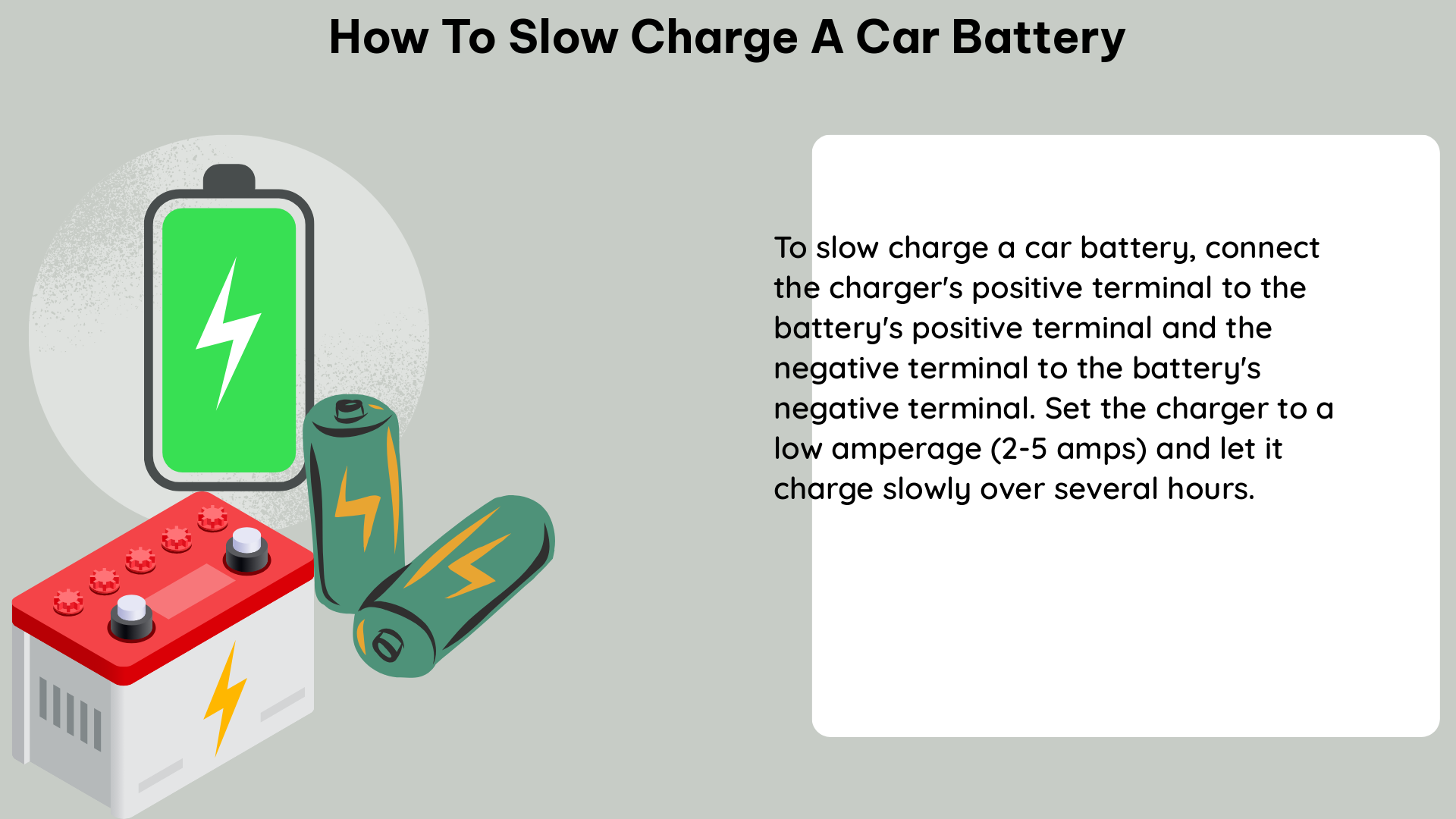Slow charging a car battery is a crucial process that can prolong the battery’s lifespan and ensure a safe, controlled charging experience. By following a methodical approach and understanding the technical specifications, you can effectively slow charge your car battery and avoid potential damage. This comprehensive guide will walk you through the step-by-step process, providing you with the necessary information to slow charge your car battery efficiently.
Choosing the Right Charger for Slow Charging
The first step in slow charging a car battery is selecting the appropriate charger. The key factor to consider is the charger’s amperage rating. For slow charging, you should use a charger with a low amperage output, typically ranging from 2 to 5 amps. This low-amperage approach ensures a gradual and controlled charge, preventing the battery from overheating or becoming overcharged.
It’s important to note that the charging time for a slow charge can vary depending on the battery’s capacity and the charger’s output. As a general rule, slow charging a car battery can take between 6 to 8 hours, while fast charging can be completed in as little as 30 minutes to 2 hours.
Accounting for Efficiency Loss

During the charging process, some energy is lost due to inefficiency. To account for this, you’ll need to apply an efficiency factor to your charging time calculation. The typical efficiency factor range is between 1.1 and 1.25, meaning you should multiply the basic charging time by this factor to get a more accurate estimate of the actual charging time.
For example, if the basic charging time is 6 hours, and you use an efficiency factor of 1.2, the actual charging time would be:
6 hours x 1.2 = 7.2 hours
This adjustment ensures that you have a realistic understanding of the time required to fully charge your car battery.
Considering the State of Charge (SOC)
If you know the current state of charge (SOC) of your car battery, you can further refine the charging time estimate. By multiplying the adjusted charging time (accounting for efficiency loss) by the percentage of charge that needs to be replenished, you can get a more precise estimate of the time required to fully charge the battery.
For instance, if your battery is at 50% SOC and the adjusted charging time is 7.2 hours, the actual charging time would be:
7.2 hours x 0.5 (50% SOC) = 3.6 hours
This approach helps you optimize the charging process and avoid overcharging or undercharging the battery.
Monitoring the Charging Process
While slow charging is a safer and more controlled method, it’s still essential to monitor the charging process closely. Keep an eye on the battery voltage and current during the charging session. Most modern chargers have built-in features to prevent overcharging, but it’s a good practice to actively monitor the process to ensure safety and prevent any potential damage to the battery.
Charging in a Cool Environment
Protecting your car battery from heat is crucial, as heat can significantly reduce its lifespan. When slow charging your battery, it’s recommended to do so in a cool environment, such as a garage or a shaded area. Exposing the battery to excessive heat during the charging process can accelerate the degradation of the battery’s internal components, ultimately shortening its overall lifespan.
Technical Specifications for Slow Charging a Car Battery
To summarize the key technical specifications for slow charging a car battery:
| Specification | Value |
|---|---|
| Charger Amperage | 2-5 amps |
| Charging Time | 6-8 hours (can vary based on battery capacity, charger output, and efficiency loss) |
| Efficiency Factor | 1.1 to 1.25 |
| State of Charge (SOC) Consideration | Multiply adjusted charging time by the percentage of charge needed to be replenished |
By following these guidelines and understanding the technical details, you can ensure a safe and effective slow charging process for your car battery, ultimately prolonging its lifespan and maintaining optimal performance.
Conclusion
Slow charging a car battery is a crucial maintenance task that can significantly extend the battery’s lifespan and prevent potential damage. By using a low-amperage charger, accounting for efficiency loss, considering the battery’s state of charge, and monitoring the charging process in a cool environment, you can ensure a controlled and safe charging experience. Remember to refer to the technical specifications provided in this guide to optimize your slow charging routine and keep your car’s battery in top condition.
References
- How Long to Charge a Car Battery
- RPM and Duration to Recharge a Battery
- The Essential Steps to Charge Your Car Battery

The lambdageeks.com Core SME Team is a group of experienced subject matter experts from diverse scientific and technical fields including Physics, Chemistry, Technology,Electronics & Electrical Engineering, Automotive, Mechanical Engineering. Our team collaborates to create high-quality, well-researched articles on a wide range of science and technology topics for the lambdageeks.com website.
All Our Senior SME are having more than 7 Years of experience in the respective fields . They are either Working Industry Professionals or assocaited With different Universities. Refer Our Authors Page to get to know About our Core SMEs.